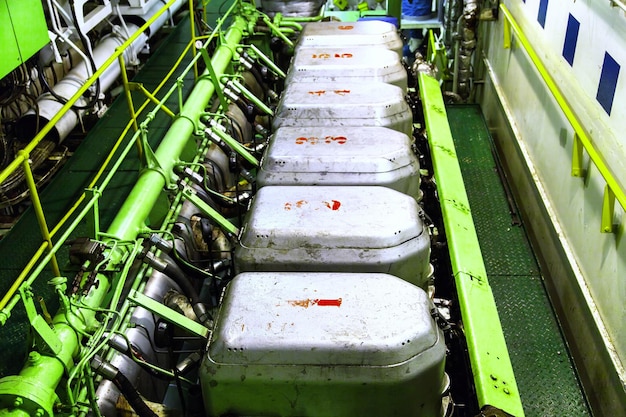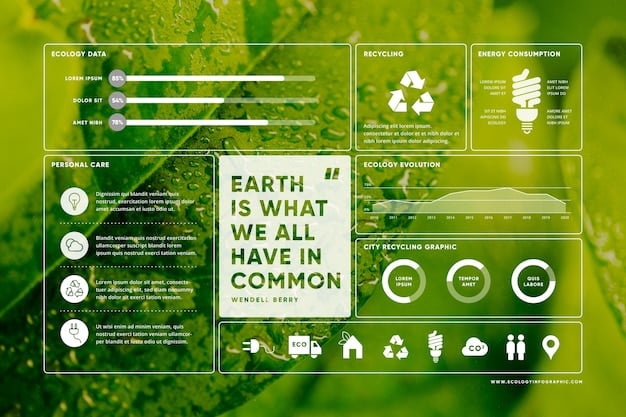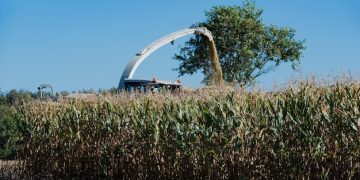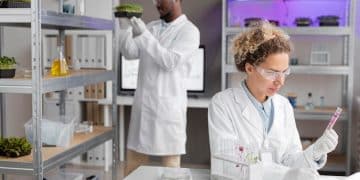Bioplastics in the US: The 2030 Potential for Plant-Based Polymers

Bioplastics in the US are gaining momentum, with plant-based polymers poised to replace traditional plastics by 2030, offering a sustainable solution to reduce environmental impact and promote a circular economy.
The United States is increasingly looking towards sustainable alternatives to combat the pervasive issue of plastic pollution. Bioplastics in the US: Exploring the Potential of Plant-Based Polymers to Replace Traditional Plastics by 2030 offers a promising path forward. Let’s delve into the potential of these innovative materials and how they could reshape our future.
Understanding Bioplastics: What Are They?
Bioplastics represent a significant shift in how we approach plastic production and consumption. They’re not just another type of plastic; they’re designed with sustainability in mind. Understanding their composition is key.
Defining Bioplastics
Bioplastics are plastics derived from renewable biomass sources, such as vegetable fats and oils, corn starch, or microbiota. Unlike traditional plastics made from petroleum, bioplastics offer a more environmentally friendly alternative.
Types of Bioplastics
There are several types of bioplastics, each with unique properties and applications. Some are biodegradable, meaning they can decompose naturally, while others are bio-based, indicating they are made from renewable resources but may not be biodegradable.

Understanding these types is crucial for assessing their environmental impact and suitability for different applications.
- Biodegradable Plastics: Can break down into natural substances under specific conditions.
- Bio-based Plastics: Made from renewable resources but may not be biodegradable.
- Compostable Plastics: Biodegrade under composting conditions.
In summary, bioplastics offer a sustainable alternative to conventional plastics by utilizing renewable resources and, in some cases, providing biodegradability.
The Current State of Bioplastics in the US Market
The bioplastics market in the US is undergoing a period of significant growth and transformation. Several factors are driving this expansion, from consumer demand to legislative changes. Let’s explore the key aspects shaping the current landscape.
Market Size and Growth
The bioplastics market in the US has seen steady growth in recent years, driven by increased awareness of environmental issues and a demand for sustainable products. While still a smaller segment compared to traditional plastics, the potential for expansion is substantial.
Key Players in the Industry
Several companies are leading the charge in bioplastics production and innovation within the US. These include established chemical companies and emerging startups, all contributing to the development and marketing of bioplastic materials.
These key players are innovating and pushing the boundaries of what’s possible with bioplastics, making the market more competitive and dynamic.
- NatureWorks: A leading producer of PLA (polylactic acid), a versatile bioplastic.
- Danimer Scientific: Specializes in PHA (polyhydroxyalkanoates), known for biodegradability.
- Origin Materials: Focuses on producing bio-based chemicals and materials.
In conclusion, the bioplastics market in the US is characterized by growth, innovation, and the presence of key players who are driving the industry forward.
Environmental Benefits of Switching to Bioplastics
One of the most compelling reasons to embrace bioplastics is their potential to mitigate environmental damage. From reducing carbon emissions to minimizing waste, the benefits are far-reaching.

These materials promise a more sustainable approach to production and consumption by reducing reliance on finite fossil fuels and contributing to a circular economy.
Reducing Carbon Footprint
Bioplastics can significantly lower carbon emissions compared to traditional plastics. By using renewable biomass sources, they reduce the dependence on fossil fuels and the associated greenhouse gas emissions.
Improved Waste Management
Biodegradable bioplastics offer a solution to the growing problem of plastic waste. These materials can break down naturally, reducing the amount of plastic accumulating in landfills and oceans.
Investing in bioplastics translates into tangible environmental benefits, from reducing our carbon footprint to better managing waste.
- Decreased Pollution: Reduces harmful chemicals released into the environment.
- Lower Energy Consumption: Requires less energy to produce compared to traditional plastics.
- Sustainable Resource Use: Utilizes renewable resources instead of fossil fuels.
In summary, switching to bioplastics offers substantial environmental advantages, primarily in reducing carbon emissions and improving waste management practices.
Challenges and Obstacles in Bioplastics Adoption
Despite the clear benefits, bioplastics adoption is not without its challenges. Several obstacles need to be addressed to facilitate widespread acceptance and use.
Cost Competitiveness
One of the primary barriers is the cost of bioplastics compared to traditional plastics. Production costs are often higher, making them less competitive in price-sensitive markets.
Performance Limitations
Some bioplastics may not match the performance characteristics of conventional plastics in terms of durability, heat resistance, or barrier properties, limiting their suitability for certain applications.
Addressing these challenges is essential to accelerate the integration of bioplastics into various industries.
Consumer Awareness and Education
Many consumers are still unaware of bioplastics or their environmental benefits. Lack of education can hinder demand and acceptance of these materials.
- Infrastructure Needs: Requires proper composting facilities for biodegradable bioplastics.
- Supply Chain Development: Building a robust supply chain for bioplastics is essential.
- Regulatory Framework: Clear standards and certifications are needed to avoid greenwashing.
In conclusion, the adoption of bioplastics faces several challenges, including cost competitiveness, performance limitations, and the need for greater consumer awareness and infrastructure development.
Policy and Regulatory Landscape in the US
Government policies and regulations play a crucial role in shaping the bioplastics market. These measures can incentivize adoption, promote innovation, and ensure environmental integrity.
Government Incentives and Subsidies
Several states and the federal government offer incentives, subsidies, and tax breaks to encourage the production and use of bioplastics, supporting the growth of the industry.
Regulations on Plastic Waste
Regulations aimed at reducing plastic waste, such as bag bans and extended producer responsibility schemes, can indirectly boost the demand for bioplastics as alternatives to traditional plastics.
Strong policies and regulations are essential to drive the bioplastics market towards greater sustainability and impact.
- Mandatory Recycled Content: Requiring a minimum percentage of bioplastics in certain products.
- Standards and Certifications: Developing clear standards for biodegradability and compostability.
- Public Procurement: Government agencies prioritizing bioplastics in purchasing decisions.
In summary, government policies and regulations are vital in fostering the growth and adoption of bioplastics, providing incentives, and setting standards for environmental performance.
Future Projections and Potential for 2030
Looking ahead to 2030, the potential for bioplastics in the US is immense. Several factors are expected to influence their growth and adoption.
Technological Advancements
Ongoing research and development efforts are focused on improving the performance characteristics of bioplastics, making them more competitive with traditional plastics.
Increased Consumer Demand
As environmental awareness continues to grow, consumer demand for sustainable products, including bioplastics, is expected to increase significantly.
The future of bioplastics depends on continued innovation, supportive policies, and growing consumer interest.
- Economic Growth: Expansion of the bioplastics industry will create new jobs and opportunities.
- Environmental Impact: Greater adoption will lead to significant reductions in plastic waste and carbon emissions.
- Market Penetration: Bioplastics could capture a substantial share of the overall plastics market by 2030.
In conclusion, the future looks promising for bioplastics in the US, with the potential for significant technological advancements, increased consumer demand, and substantial market penetration by 2030.
| Key Point | Brief Description |
|---|---|
| 🌱 Bioplastic Types | Biodegradable, bio-based, & compostable plastics explained. |
| 🏭 US Market | Growth driven by eco-awareness & key industry players. |
| 🌍 Environmental Benefits | Reduced carbon footprint & improved waste management. |
| ⚖️ Policy Impact | Government incentives boost bioplastics adoption. |
FAQ
▼
Bioplastics are primarily derived from renewable biomass sources such as corn starch, sugarcane, vegetable oils, and even agricultural waste. These sources provide a sustainable alternative to fossil fuels.
▼
No, not all bioplastics are biodegradable. Some are bio-based, meaning they are made from renewable resources, but they may not necessarily break down naturally. Biodegradability depends on the specific type.
▼
The main benefits include a reduced carbon footprint due to the use of renewable resources, decreased reliance on fossil fuels, and improved waste management, particularly with biodegradable varieties.
▼
Challenges include higher production costs compared to traditional plastics, performance limitations in certain applications, and the need for increased consumer awareness and better waste management infrastructure.
▼
Government policies support bioplastics through incentives, subsidies, regulations on plastic waste, and the establishment of standards and certifications. These measures drive innovation and market adoption.
Conclusion
In conclusion, the transition to bioplastics in the US by 2030 presents a significant opportunity to reduce our environmental impact and foster a more sustainable future. While challenges remain, ongoing innovation, supportive policies, and growing consumer demand are paving the way for a greener, more circular economy.





